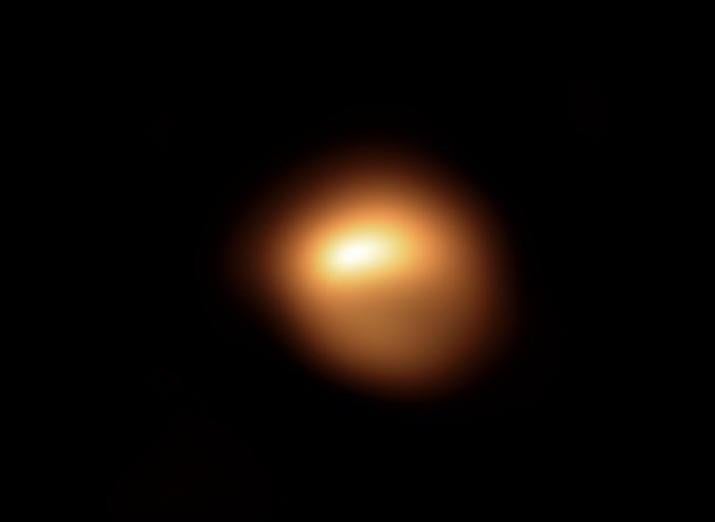This website uses cookies so that we can provide you with the best user experience possible. Cookie information is stored in your browser and performs functions such as recognising you when you return to our website and helping our team to understand which sections of the website you find most interesting and useful.

A well-known star is behaving oddly and appears to have changed shape, according to astronomers
Betelgeuse – a red supergiant that can be seen in the constellation Orion – has historically been one of the sky's brightest stars. But in recent months it has started to dim in a way never before seen, and without explanation.
Some astronomers had initially speculated that the star could be about to explode into a supernova, in a dramatic event that would be visible from Earth. But astronomers now think that something else is happening, which is changing the star in unexpected ways.
Now new images show that fading brightness of the star, as well as the fact that the shape as it appears to us appears to be changing.
As it has continued to dim, Betelgeuse is now about 36 per cent of its normal brightness. That is so dramatic that it can be seen with the naked eye, but further investigations with telescopes have attempted to learn more about the mysterious dimming.
Created with Sketch.
Created with Sketch.
1/10
Mystic Mountain, a pillar of gas and dust standing at three-light-years tall, bursting with jets of gas flom fledgling stars buried within, was captured by Nasa's Hubble Space Telelscope in February 2010
Nasa/ESA/STScI
2/10
The first ever selfie taken on an alien planet, captured by Nasa's Curiosity Rover in the early days of its mission to explore Mars in 2012
Nasa/JPL-Caltech/MSSS
3/10
Death of a star: This image from Nasa's Chandra X-ray telescope shows the supernova of Tycho, a star in our Milky Way galaxy
Nasa
4/10
Arrokoth, the most distant object ever explored, pictured here on 1 January 2019 by a camera on Nasa's New Horizons spaceraft at a distance of 4.1 billion miles from Earth
Getty
5/10
An image of the Large Magellanic Cloud galaxy seen in infrared light by the Herschel Space Observatory in January 2012. Regions of space such as this are where new stars are born from a mixture of elements and cosmic dust
Nasa
6/10
The first ever image of a black hole, captured by the Event Horizon telescope, as part of a global collaboration involving Nasa, and released on 10 April 2019. The image reveals the black hole at the centre of Messier 87, a massive galaxy in the nearby Virgo galaxy cluster. This black hole resides about 54 million light-years from Earth
Getty
7/10
Pluto, as pictured by Nasa's New Horizons spacecraft as it flew over the dwarf planet for the first time ever in July 2015
Nasa/APL/SwRI
8/10
A coronal mass ejection as seen by the Chandra Observatory in 2019. This is the first time that Chandra has detected this phenomenon from a star other than the Sun
Nasa
9/10
Dark, narrow, 100 meter-long streaks running downhill on the surface Mars were believed to be evidence of contemporary flowing water. It has since been suggested that they may instead be formed by flowing sand
Nasa/JPL/University of Arizona
10/10
Morning Aurora: Nasa astronaut Scott Kelly captured this photograph of the green lights of the aurora from the International Space Station in October 2015
Nasa/Scott Kelly
1/10
Mystic Mountain, a pillar of gas and dust standing at three-light-years tall, bursting with jets of gas flom fledgling stars buried within, was captured by Nasa's Hubble Space Telelscope in February 2010
Nasa/ESA/STScI
2/10
The first ever selfie taken on an alien planet, captured by Nasa's Curiosity Rover in the early days of its mission to explore Mars in 2012
Nasa/JPL-Caltech/MSSS
3/10
Death of a star: This image from Nasa's Chandra X-ray telescope shows the supernova of Tycho, a star in our Milky Way galaxy
Nasa
4/10
Arrokoth, the most distant object ever explored, pictured here on 1 January 2019 by a camera on Nasa's New Horizons spaceraft at a distance of 4.1 billion miles from Earth
Getty
5/10
An image of the Large Magellanic Cloud galaxy seen in infrared light by the Herschel Space Observatory in January 2012. Regions of space such as this are where new stars are born from a mixture of elements and cosmic dust
Nasa
6/10
The first ever image of a black hole, captured by the Event Horizon telescope, as part of a global collaboration involving Nasa, and released on 10 April 2019. The image reveals the black hole at the centre of Messier 87, a massive galaxy in the nearby Virgo galaxy cluster. This black hole resides about 54 million light-years from Earth
Getty
7/10
Pluto, as pictured by Nasa's New Horizons spacecraft as it flew over the dwarf planet for the first time ever in July 2015
Nasa/APL/SwRI
8/10
A coronal mass ejection as seen by the Chandra Observatory in 2019. This is the first time that Chandra has detected this phenomenon from a star other than the Sun
Nasa
9/10
Dark, narrow, 100 meter-long streaks running downhill on the surface Mars were believed to be evidence of contemporary flowing water. It has since been suggested that they may instead be formed by flowing sand
Nasa/JPL/University of Arizona
10/10
Morning Aurora: Nasa astronaut Scott Kelly captured this photograph of the green lights of the aurora from the International Space Station in October 2015
Nasa/Scott Kelly
Since December, astronomers have observed the star using the ESO's Very Large Telescope, in an attempt to understand the strange behaviour of the star.
They have now revealed a stunning new image of the star's surface. Helpfully, they took a very similar image, using the same instrument, in January 2019 and before the dimming began – allowing them to compare the two images, and understand more about the changes that Betelgeuse has undergone.
Researchers now speculate that the star is not in fact about to go supernova, but is undergoing some other, similarly dramatic process. The new research helps give insight into red supergiants like Betelgeuse and what could happen to cause such unusual behaviour.
"The two scenarios we are working on are a cooling of the surface due to exceptional stellar activity or dust ejection towards us," said Miguel Montargès, an astronomer from KU Leuven in Belgium, who led the new study. "Of course, our knowledge of red supergiants remains incomplete, and this is still a work in progress, so a surprise can still happen."
Other images taken using the same Very Large Telescope show that the dust around Betelgeuse is emitting infrared light. That appears to happen when the material that makes up the star is spewed back into space.
"The phrase 'we are all made of stardust' is one we hear a lot in popular astronomy, but where exactly does this dust come from?" siad Emily Cannon, a PhD student at KU Leuven.
"Over their lifetimes, red supergiants like Betelgeuse create and eject vast amounts of material even before they explode as supernovae. Modern technology has enabled us to study these objects, hundreds of light-years away, in unprecedented detail giving us the opportunity to unravel the mystery of what triggers their mass loss."



 Africana55 Radio
Africana55 Radio 

